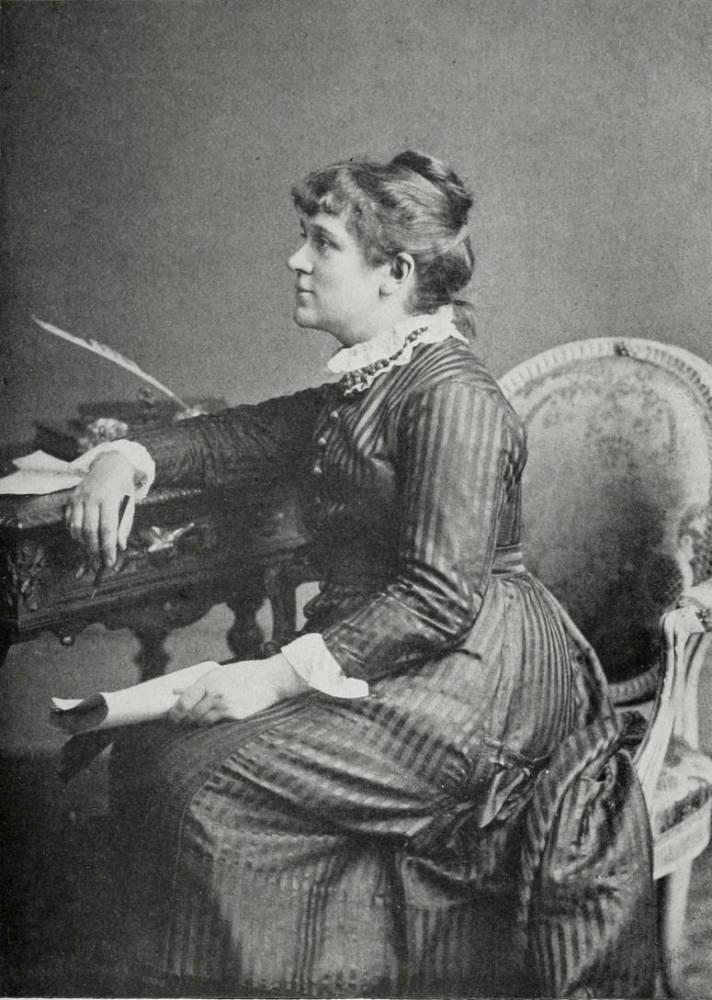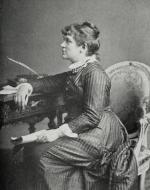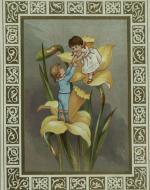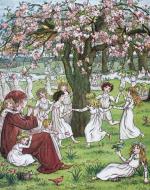Created by Grace Brown on Thu, 03/21/2024 - 20:15
Description:
Kate (Catherine) Greenaway (1846-1901) was born in Hoxton, London, to a dressmaker mother and an illustrator father. Greenaway took after her parents early in life: she became a skilled seamstress by her mother's hand and displayed a love and talent for art from watching her father. She spent a relatively brief part of her childhood in Nottinghamshire after her father sent the family to live with some relatives while he worked on an engraving project, but the time had an immense impact on the still young Kate Greenaway. The location and landscape later became a staple in her illustrations. Once back in Hoxton, Greenaway became a full-time student at the Finsbury School of Fine Arts by twelve years old and formally began her artistic career while at school by producing greeting and holiday cards for Marcus Ward & Co. Only later in 1879 did Greenaway produce the first of two books written and illustrated entirely on her own, Under the Window: Pictures and Rhymes for Children. This book is full of idealistic, rural areas and children dressed in historical costumes paired with simple rhymes, becoming an instant best-seller with over 100,000 copies sold in Greenaway’s lifetime. A combination of the success from her first book and growing popularity as an illustrator sparked the “Greenaway look,” a style that started to become popular among Victorian girls. The Regency era costuming in nearly all of Greenaway’s pieces is a staple of her work, and as her notoriety continued to grow, so, too, did the desire to dress similarly to her characters. This popularity was amplified by the support of Arthur Lasenby Liberty, founder of Victorian furnishing and dress company Liberty & Co, who sold dresses in his store similar to the ones Greenaway illustrated. In her career, Greenaway illustrated over 150 books and was featured in three exhibits by the Fine Arts Society during her lifetime and another after her passing. Her legacy as a children’s illustrator extends far beyond her lifetime though; the Kate Greenaway Medal (renamed in 2023 as the “Carnegie Medal for Illustration”) is an award established in 1955 that annually recognizes exceptional work in illustration for a children’s book. The awards for the medal have wavered over time, but since 2000, the winner receives £500 in donated children’s books to a chosen library and a £5000 cash prize along with the medal itself. This medal has been awarded nearly every year since conception-- a prestigious award, given its unique nature in focusing on both children's books and illustrations themselves. Despite the name change in recent years, this award has carried Kate Greenaway’s impact and legacy well into the modern day.
Elliott & Fry, Photograph entitled "Kate Greenaway in 1880," reproduced in Spielmann and Layard, 'Kate Greenaway' page 84, Mary Evans Picture Library. This portrait of Kate Greenaway (1846-1901) was taken by Elliott & Fry, a Victorian photography studio, when she would have been thirty-four years old. Born in 1846 in Hoxton, London, as the second child of four, Greenaway was the daughter of a dressmaker mother and engraver-illustrator father, John Greenaway. The family moved to Islington in her childhood, and Kate later moved once again to a home in Frognal, London, where she would ultimately pass.
Kate Greenaway, "Children of Flowers," for Marcus Ward & Co, 1877, the Library of Birmingham, Wikipedia. Greenaway was hired by the renowned Marcus Ward & Co in 1871 as a freelance artist to make greeting cards, and one of them is depicted here. Her cards sold well, especially enjoyed for her costuming of figures and choice of colors. Greenaway's ability with costuming came from her mother and her own great sewing abilities. She illustrated greeting cards as well as Christmas and Valentine's day cards for the company.
Kate Greenaway, "School is Over," for Under the Window: Pictures and Rhymes for Children, 1879, scanned image by Simon Cooke, The Victorian Web. Under the Window was Greenaway's first of only two books to be entirely written and illustrated by herself. It is a children's picture book showing idyllic scenes of children throughout their days, accompanied by short rhyming verses. Much like her father before her, Greenaway used woodblock engravings in order to illustrate her books, and this book sold over 100,000 copies in her lifetime both in and out of England, helping her truly begin her career as a children's book illustrator. One of the staples of Greenaway's childrens books are the costumes the children wear, pulled from the century before in the Regency era.
Kate Greenaway, Frontispiece for Robert Browning, for The Pied Piper of Hamelin, 1888, scanned image by Jacqueline Banerjee, The Victorian Web. Although Greenaway only produced two of her own books in full, she was commissioned as an illustrator on over 150 books written by others, one of which being The Pied Piper of Hamelin by Robert Browning. This frontispiece is described by Browning as one of Greenaway's best, and it is easy to see why; the scene is full of movement and life, showing children dressed in white and frolicking through a land dotted with cherry trees in bloom, helping draw attention tothe Piper in his entirely red outfit. The trees and natural landscape alongside the few animals in the picture show Greenaway's talent for more than just humans in Regency costumes, but also the Piper and children themselves who are really the centerpiece of the illustration.
Bibliography:
The Victorian Web. < https://victorianweb.org/art/illustration/greenaway/bio.html >. Web. 14 April 2024.





